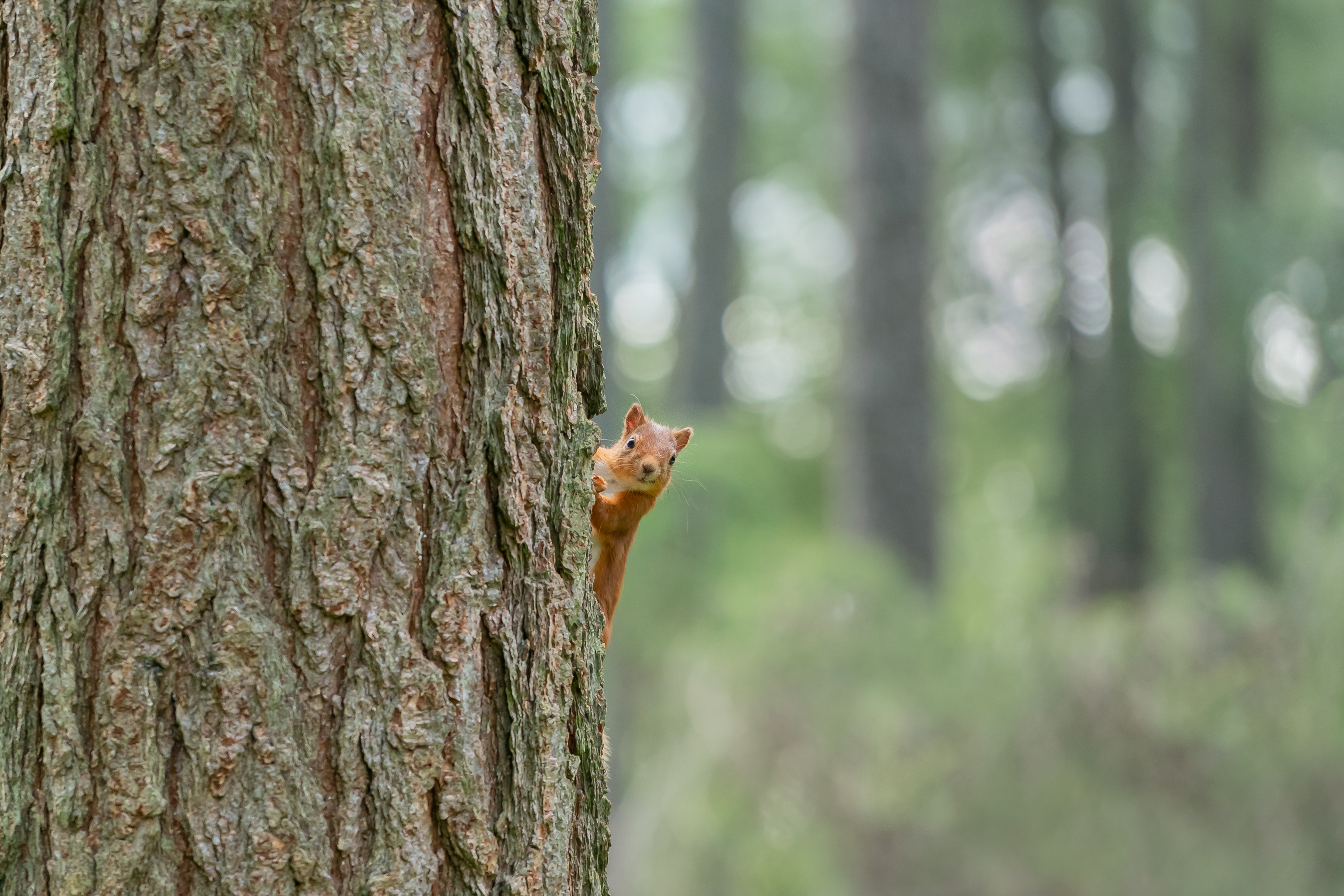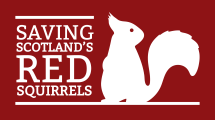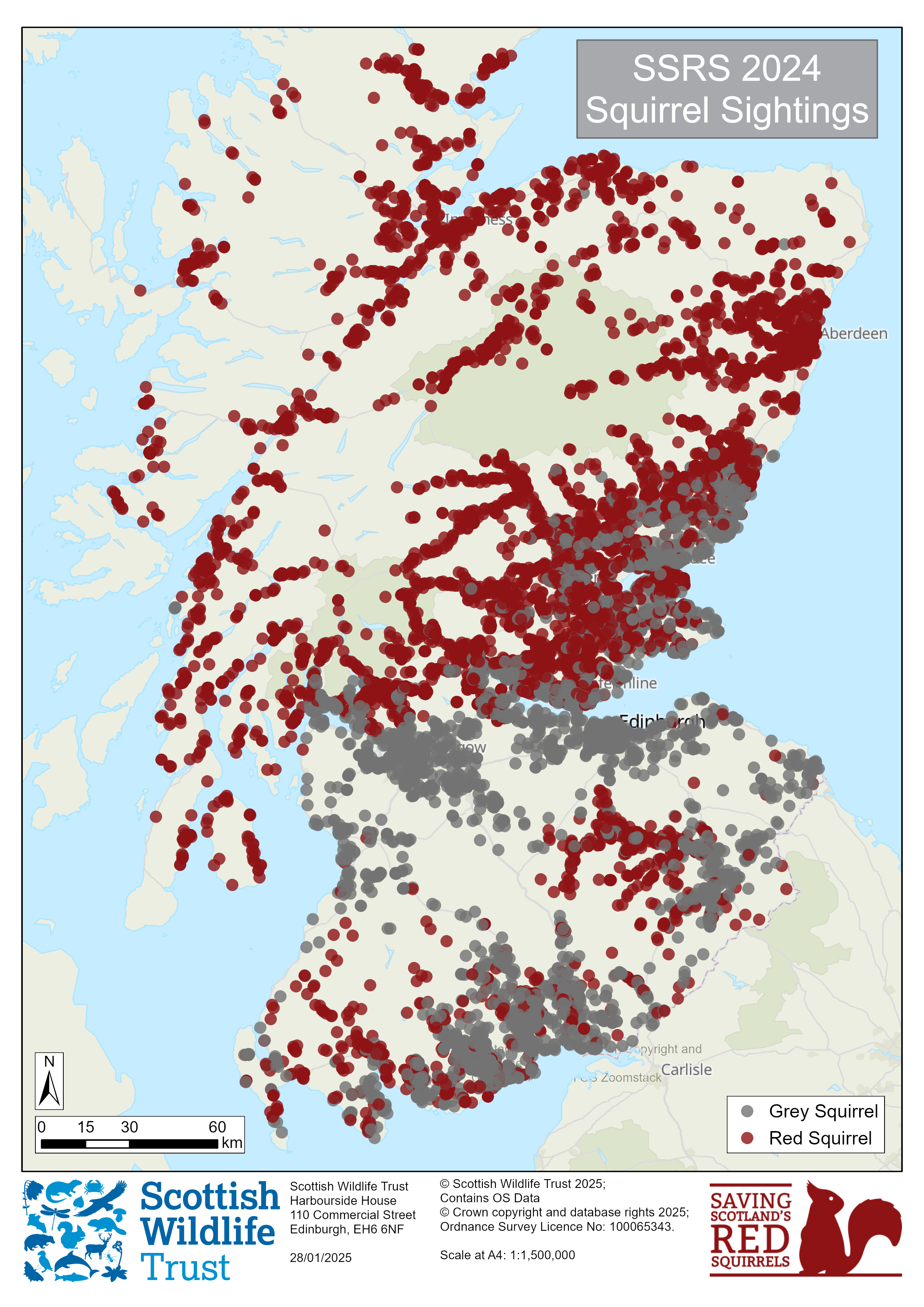Public squirrel sightings are an invaluable resource for SSRS staff and volunteers, and submitting a sighting is a fantastic opportunity to contribute to crucial citizen science efforts and aid in the fight to save Scotland’s red squirrels. But why are squirrel sightings so important, what exactly does the map show, and how should sightings be reported? Our latest FAQ blog answers some of our frequently asked squirrel sightings questions, shedding more light on this incredible conservation tool!
SSRS has been collecting public squirrel sightings since 2010. This data is not only crucial in helping us understand how grey and red squirrel distributions are changing over time across the country, it also helps our team and local volunteers take direct conservation action on the ground to protect endangered red squirrels and ensure they continue to be part of Scotland’s special native wildlife.
You can report all sightings via our website. This page will take you to a short form with space to enter key information about your sighting such as species, date, habitat type, location etc. This is very easy to do and should just take a few minutes, but if you have any issues please email us on squirrels@scottishwildlifetrust.org.uk.
Red squirrel populations have seriously declined throughout the UK over the last century with only around 287,000 remaining, about 80% of which are estimated to be in Scotland.
The greatest threat to the red squirrel’s future in Scotland is the invasive non-native grey squirrel. First introduced in Victorian times, the larger and more robust grey squirrel out-competes reds for food and living space, making it difficult for them to successfully breed and for their young to survive. When grey squirrels move into a new area, red squirrels can be completely replaced within 15 years.
Some grey squirrels also brought squirrelpox, a virus they carry without harm to themselves. Red squirrels have no natural immunity to squirrelpox, and the disease is usually fatal within two weeks. When squirrelpox is present, grey squirrels can replace red populations around twenty times as fast as they can through competition alone.
It can sometimes be quite tricky to tell the difference between grey and red squirrels, especially in low lighting or when reds are wearing their thicker, and often quite grey looking (!), winter coats. Grey squirrels can also occasionally have a reddish tinge to their fur. The only sure way to tell the two species apart is by the white fringe or ‘halo’ around the edge of grey squirrel tails. Read more here. If you are still unsure you can take a photo and send it into us at squirrels@scottishwildlifetrust.org.uk.
For reds seen regularly in the same spot (for example at garden feeders) just report the maximum amount seen at any one time 2-3 times a year. For greys, please report each time you see one. This is so we don’t miss any crucial grey sightings in areas where they may be incurring on existing red populations.
If you very sadly spot a dead squirrel of either species, please report your sighting via the website as you would with alive squirrels. There are two options to pick from, either ‘dead’ or ‘dead on the road’. In either case you can put further details in the ‘any other information’ comments box.
If you find a dead red squirrel that looks obviously diseased, please take photos and contact your nearest SSRS Regional Lead or email squirrels@scottishwildlifetrust.org.uk immediately so that follow-up action to protect local red squirrels can be taken if necessary.
We also request that any other dead red squirrels you find are sent for post-mortem, even if it is clearly a road victim that looks otherwise healthy. Our colleagues at the Royal (Dick) School of Veterinary Studies are carrying out a long-term health study of Scotland’s wild red squirrels and these specimens are a valuable contribution to that work. A copy of our guidance on how to carefully handle, package, and label the squirrel carcass can be downloaded here.
If you spot a sick or injured looking red squirrel, please report your sighting via the website putting as much detail as possible in the ‘any other information’ comments box.
If you can please also take photos and contact your nearest SSRS Regional Lead or email squirrels@scottishwildlifetrust.org.uk immediately so that follow-up action to protect local red squirrels can be taken if necessary.
If you are worried about a red squirrel’s immediate welfare, including abandoned kits, please contact the Scottish SPCA on 03000 999 999.
If you spot a squirrel of either species in a particularly unusual location (for example a red squirrel in the Central Belt, or a grey squirrel in the Highlands) please take a photo, or capture video footage if you can, and email to squirrels@scottishwildlifetrust.org.uk as well as reporting on the website as normal.
If you think you might submit more sightings in the future we would recommend registering for an account on our Community Hub. This will mean your contact details will be remembered and automatically filled in for every sighting you make, and you will be able to view all your previous squirrel sightings in one place.
Every single sighting that we receive is looked at in detail and verified by a member of SSRS staff or trained volunteer to make sure all the details are correct (we have had the occasional sighting indicating squirrels swimming in the north sea, for instance!). Until a sighting has been verified it doesn’t appear on the public map – we get a lot of sightings, and the team can sometimes be quite busy, but do get in touch with us if you don’t see your sighting pop up after a few weeks.
We sadly can’t get back to everybody (in 2024 alone the team verified over 17,000 individual squirrel sightings!) but rest assured we really appreciate every single sighting we receive as they all help to build a picture of red and grey distributions across Scotland. Some sightings might require further action (for example sick reds, or a grey in one of our priority areas ) in which case a member of staff or volunteer may be in touch to get further information or see if you would like to sign up to our trap loan scheme.
The mapping system we use records to an accuracy of 100 square metres and puts sightings at the bottom left of the 100 square metres they are recorded in. As such sometimes the more precise squirrel sightings can appear in the wrong location.
Please rest assured that all sightings are verified by SSRS staff members and/or trained volunteers, and if they ever want further precise information about where a squirrel was sighted, they will get in touch directly.
We encourage reporting sightings from all over Scotland, no matter where in the country you are based. Grey squirrel sightings are incredibly important, especially across our funded priority areas where public detections are crucial to landscape-scale grey control professional SSRS staff, landowners, and volunteers are carrying out.
We do know that that there are significant populations of grey squirrels in the central belt in Scotland, and there is under-reporting in this area. Rest assured we are aware of these populations, and that the map and graphs on our sightings page are not intended as a population count of either species.
We received more sightings submissions in 2020 than in any other year so far (over 22,000!), largely down to people reporting sightings whilst out for daily walks during the covid-19 pandemic. In 2022, in contrast, SSRS staffing vacancies and changes meant we had less capacity to promote the map and so received fewer sightings.
As such, the numbers on our sightings page should never be used to make conclusions on squirrel population counts or changes in Scotland, as many different external factors affect the total tallies. The main aim of the map is to help us ascertain where both species are distributed across the country, and to assist in identifying where incurring grey squirrels may be threatening key existing red populations.
As above becuase the mapping system we use only records to an accuracy of 100 square meters, the exact location of any red squirrel is never publicly visible.
Wildlife watching is an incredibly rewarding and engaging experience, if done sensitively and in a manner which does not disturb individuals or their habitat. Anybody doing so should follow the Scottish Outdoor Access Code which sets out guidance and regulations to follow for responsible access to land as per the Land Reform (Scotland) Act 2003. The full code can be found here.
All verified sightings are annually added to the Scottish Squirrel Database, a national record of red and grey squirrel distributions which helps form the basis of long-term plans for red squirrel conservation. This is hosted on the National Biodiversity Network (NBN), which is used by governments, ENGOs, local authorities etc to exchange biodiversity information (including on various invasive non-native species, such as grey squirrels). Any data shared is done so in accordance with our Privacy Policy and Terms of Service.
Phew that’s a lot of questions! Now you know all there is to know about spotting grey and red squirrels, what are you waiting for? Submit those all-important sightings year round, and contribute towards vital efforts to save Scotland’s red squirrels, via our website: scottishsquirrels.org.uk/squirrel-sightings/




